Where to go on weekends, follow in the footsteps of the uncle and wander around Rongchang
Antao Town - Xiabu Town - Wanling Ancient Town - Gufoshan - Qingjiang Ancient Street - Hezhong Island - Village Farm
Weekend 2-day tour around Chongqing
Day 1: Chongqing City - Gufoshan - Qingjiang Ancient Street - Hezhong Island - Village Farm:
Accommodation: Farmhouse tourism on the village farm.
Starting from Chongqing, my first stop will be directly to Gu Foshan. The journey from Chongqing to Gu Foshan takes about 2.5 hours.

Gufo Mountain is steep and majestic, with steep and rocky terrain and beautiful scenery. It includes small attractions such as Gufo Temple, Xianren Cave, Xiongshi Rock, and Changliang Cave. There are also attractions such as Gugu Village at the foot of the mountain, making it a great place for exploration, rock climbing, pilgrimage, and Buddha worship. When the paulownia flowers bloom in mid to late April every year, it is a period of extremely beautiful scenery in Gufo Mountain, which is shocking, joyful, intoxicating, and unforgettable.

Gu Foshan is an ecological leisure tourism area and a key rural leisure tourism area developed by Rongchang. In recent years, the Gufoshan Scenic Area has firmly grasped the practical opportunity of positioning itself as an "ecological leisure protection zone". With ecological leisure as the theme, it has systematically created a multifunctional ecological leisure and health tourism area that integrates rural recreation, leisure and entertainment, cultural experience, and health and elderly care. With the three major goals of building an "outdoor fitness destination, agricultural culture base, and health and elderly care paradise", it has focused on strengthening the construction of infrastructure, scenic spots, and supporting facilities.

In the Gufoshan Scenic Area, my favorite Baifo Garden. There are 99 "Buddha" characters engraved in the Hundred Buddha Garden, each of which is carved by a different famous calligrapher. When you arrive at the Hundred Buddha Garden on the ancient Buddha Mountain, you will arrive at a calligraphy exhibition where visitors can appreciate the calligraphy works of famous calligraphers such as Wang Xizhi, Huai Su, Su Shi, Huang Tingjian, Tang Yin, and Mao Zedong. Each "Buddha" character in Baifo Garden has a different meaning, in addition to the different calligraphy font ages. There are children worshiping Guanyin, temporarily holding the feet of the Buddha, and other characters with different meanings of Buddha sitting among them. The font image is specific, consisting of two characters to form the Buddha character, which represents a kind of piety and teaches people to be serious and responsible in doing things.



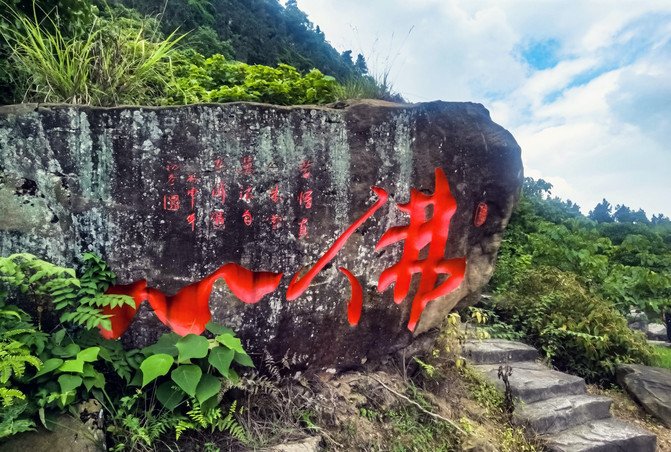




Gufoshan Hanging Glass Bridge
The first suspended glass cable bridge in Rongchang is located in the Qingsheng Ancient Buddha Mountain Scenic Area of Rongchang District. The total length of the cable bridge is 81 meters and the width is 2.4 meters. Standing on the transparent glass as if suspended in the air, the bridge deck sways left and right as you reach the middle. In addition to the thrilling excitement, through the glass bridge deck, you can have a panoramic view of the beautiful scenery around you.


Glass slide and glass drift in Gufoshan Scenic Area
The dry slide is 200 meters long, and the drifting slide is 1200 meters long. The slide is made of tempered glass. During the entire drifting process, tourists can walk through the mountains, forests, and streams. While following the curves of the drift, their bodies can experience a comprehensive range of visual, auditory, and tactile sensations. The drifting slide is open to tourists all year round because it has been professionally improved to separate the water flow from the ship's body. Drifting does not wet the body, and tourists do not need to deliberately prepare to change clothes. Let you feel the "speed and passion" here.

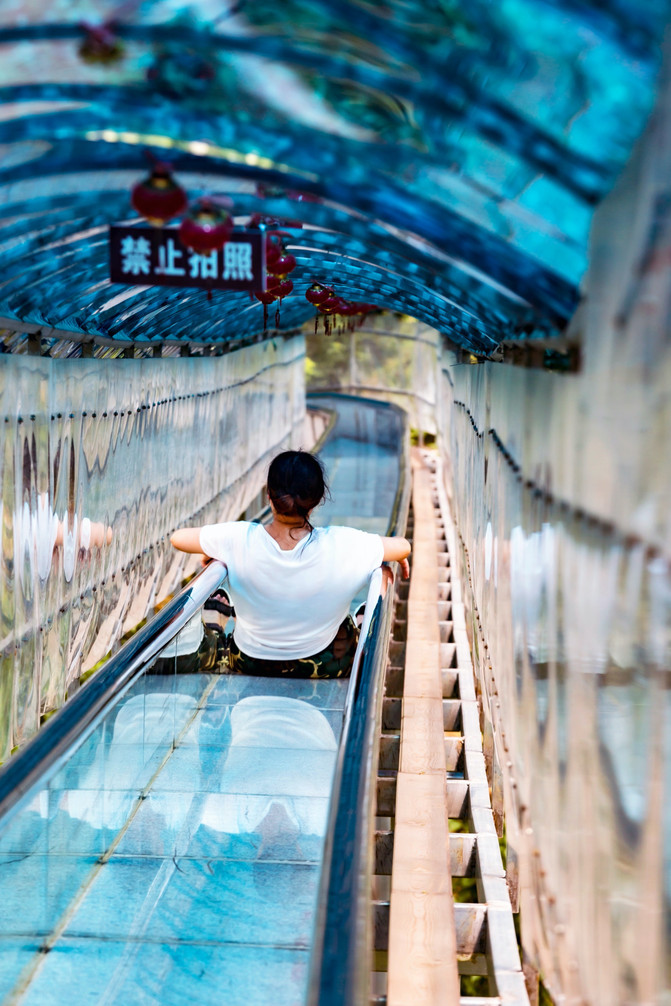
At present, the Gufoshan Scenic Area has formed a series of health and leisure projects that integrate mountaineering, fitness, fruit picking, and tea tasting. The scenery of the fruit forest at the foot of the mountain and the green tea garden on the mountain is picturesque; Hundred Buddha Garden, Three Holy Caves, Arhat Hall and other scenic spots are naturally formed; Strolling or cycling along the colorful lakeside trail for fitness and leisure; Climbing mountains for distant views, cleansing the lungs and nourishing the heart; Pick cherries, loquats, plums, pears and other seasonal fruits, and taste rural green dishes such as local bacon, muddy water cake, tea and tofu pudding; Combined with the thrilling glass cable bridge, it will definitely satisfy your leisurely yet fun gaming experience.
After visiting Gu Foshan, we drove to Qingjiang Ancient Street.
Qingjiang Ancient Street
A river, Qingjiang. There is a century old street called "Qingjiang Ancient Street" by the river, a small town with a history of hundreds of years, adjacent to Luxian County, Sichuan Province. Two counties are separated by a river, with the river's center as the boundary. You can tell the boundary line from the bridge pier in the following picture. The scenery by the river is pleasant, the air is cool, and in summer, under the shade of trees by the river, shaking a fan to cool off is not a good place.



Qingjiang Town is uniquely located on the southwestern edge of Rongchang District, at the junction of Chongqing and Sichuan provinces. It borders Luxian County in Luzhou City, Sichuan Province. The town of Qingjiang is located on the border of the province, so crossing provinces in Qingjiang town is also a matter of minutes.



The quaint streets and citizens present a prosperous scene here. This small town is quite famous for its fermented soybean fish, and you must experience it when visiting this town.



Hezhong Island
The ecological tourism and sightseeing of Hezhong Island is surrounded by the river on all sides, with a width of 100 meters, a length of 5.5 kilometers, and an average depth of 7 meters. The water of the Laixi River flows around it, forming a unique natural landscape of the island surrounded by water. There are already a large number of fruit trees planted on the island, which are like spring all year round. The ancient trees provide thick shade, and the flowers and fruits are fragrant all year round. There are also old longan trees and yellow ash trees with a history of more than 100 years. Fenshuiya Rock Flying Spring, with dense bamboo cultivation stretching for several miles along the shore, occasionally frequented by rare waterfowl playing and frolicking. The river at the fork of the island is turbulent, and the Huilong Cave is deep and quiet. The ancient appearance of Huilong Temple still exists. The Mantou mountains in the island are well proportioned, with complete mountain, water, road and forest facilities and natural shapes. It is also known for "natural wonders, unique images and magical legends", and is known both inside and outside the county for its elegant reputation of "Little Taiwan".


There are many fruits and vegetables on the island, and playing on the island, picking fruits and vegetables, is a pleasure from time to time. In May, among the dense leaves of loquat trees, there are clusters of loquat, round and swollen. Under the sunshine, they are golden and transparent, full of enthusiasm.


In September, the longan on the island is basically mature. There are 13 century old longan trees on the island, which are over 15 meters high and have a trunk diameter of 40-60 centimeters. The longan they grow is thick in flesh and small in core, with a sweet taste like honey. During the harvest season, it is always the busiest time for Hezhong Island. Would you take your children and family to experience the joy of such a bountiful harvest together?




Village Farm
This place gathers places for picking, accommodation, and rural tourism. On weekends, taking children to the fields to catch fish, touch shrimp, and pick vegetables, personally cooking and cooking delicious food, is a great joy.





Qingjiang Town is mainly focused on rural tourism, and its natural resources are very abundant. The Laixi River has added infinite resources to this village, making this small town more vibrant.
Kind reminder: Farmhouse accommodations here are very scarce. Friends who are going to play should contact housing in advance.
The next day: Antao Town - Xiabu Town - Wanling Ancient Town - Return to Chongqing City
After enjoying a rich breakfast at the village farm farmhouse, drive to Antao Town.
Antao Town
The overall layout of Antao Town is "ancient streets and water lanes". In addition to the 400 meter long Taobao Ancient Street, a 1.1-kilometer-long and tens of meters wide Tashui River will also be built. Cleverly utilizing water ditches and channels, the water lanes will be separated into individual gardens, creating the effect of "water surrounding the ancient town and pottery fragrance leisurely". The kimchi jar is the most representative living pottery of Rongchang pottery, with a reputation of hundreds of years. The kimchi jar produced by Rongchang has a very full shape and delicate texture. The entire kimchi jar has good breathability, and the kimchi soaked with it will not produce flowers or odors, making it very delicious. As a result, it has become widely popular, and in the Yungui River region, almost every household has several kimchi jars. In the 1950s and 1960s, the kimchi jar made by Rongchang pottery master won the gold medal in the first national pottery competition. Since then, Rongchang kimchi jar has further gained popularity nationwide and become a representative product of Rongchang pottery.



Starting from the village farm, after about an hour's drive, we arrived among the tourists in Antao Town. After parking the car, we strolled through Antao Town to learn about the history of Rongchang pottery, both ancient and modern, as well as its production techniques. Rongchang pottery originated in the Song Dynasty. It is as red as jujube, as bright as a mirror, as thin as paper, and as melodious as a drum. The so-called 'red as jujube' refers to the red luster and warm like jade that pottery presents after being glazed and fired; The so-called 'thin as paper' refers to the skilled hands of ceramic workers pulling out clay blocks that are as thin as paper to make various shapes; The so-called "bright as a mirror" refers to the smooth and transparent glaze of pottery, which can reflect human figures; The so-called 'sound as loud as a bell' refers to using fingers to tap on pottery, which can produce beautiful music like a bell. This is the unique charm of Rongchang pottery.






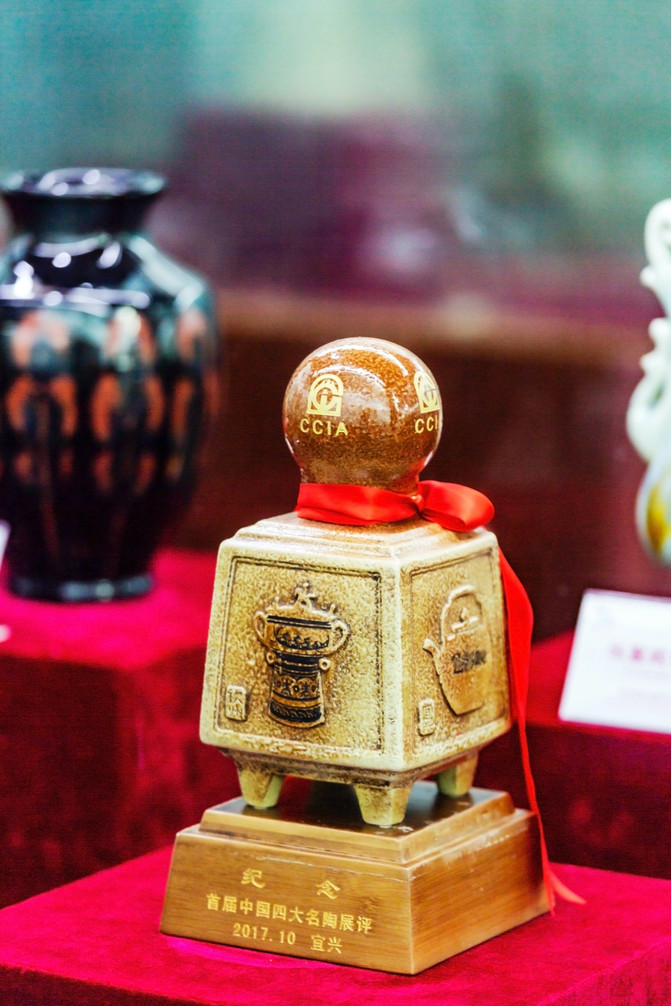
Exquisite craftsmanship has earned Rongchang pottery the reputation of being as red as jujube, as shiny as a mirror, as thin as paper, and as melodious as a thousand voices. The meticulous inheritance process has enabled Rongchang pottery to be passed down to nine provinces and exported to more than 30 countries and regions around the world.
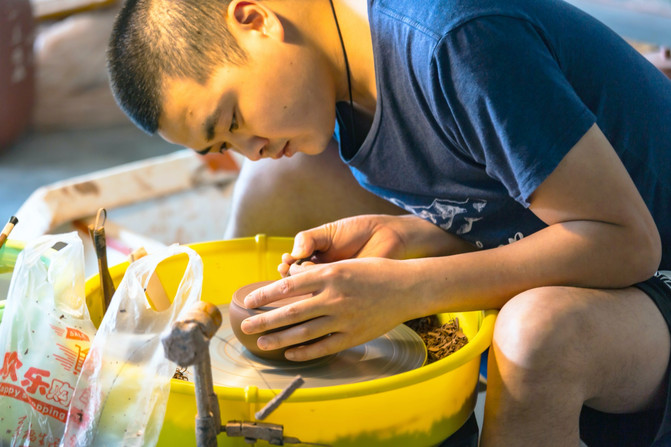




Taobao Ancient Street in Antao Town is also known as "Xiazhazi Gate" by the local people. From the couplet, it is easy to see that our ancient pottery city not only boasts the beautiful scenery of the majestic Ya Island, but also the precious wealth of the Chinese people, Rongchang pottery. The city walls on both sides of the gate are modeled after the Yayu Mountain Range behind, which is also the production area of our Rongchang pottery raw materials. The place where you are standing now is Tashui Bridge, and the bridge deck of Tashui Bridge is paved with ceramic bricks made of Rongchang pottery red clay.


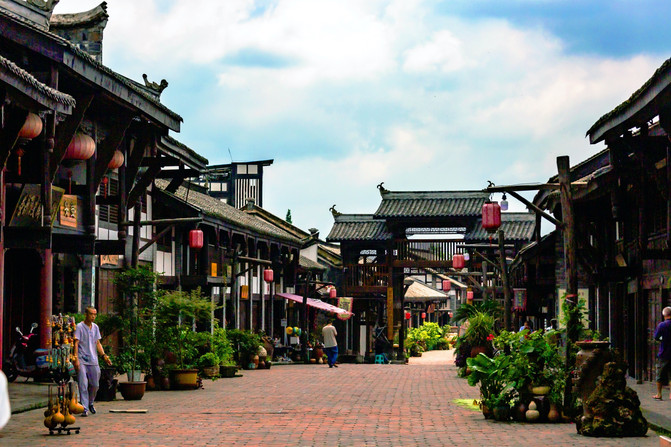


Xiabu Town
Originating from the Han Dynasty, it has excellent texture and has been passed down through generations. As light as cicada wings, as thin as rice paper, as flat as a water mirror, and as fine as silk. Made into clothing, comfortable and soft, refreshing and breathable, easy to dry sweat. In the Tang Dynasty, high-quality Rongchang summer cloth was presented as tribute to the court, adorned with beautiful women to fill the harem, and packaged for the emperor to sit on a dragon bed. Rongchang summer cloth, along with Hunan and Jiangxi, is now known as one of the three major summer cloth production bases in China. Rongchang summer cloth is not only a fine item of clothing, but also a cross-border alliance with painting and calligraphy art, exported to Europe, America, South Asia, Japan, and South Korea. There is a poem praising it: Spring waves under Guanyin Bridge are green, and summer cloth is dyed and spread across five continents.
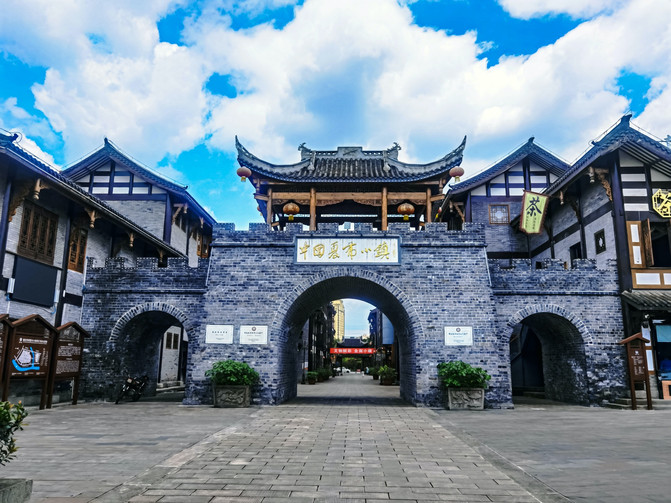
In the Xiabu Museum, the historical development, production techniques, and various products of Xiabu are displayed. In the weaving process of summer cloth production, it mainly goes through processes such as hemp beating, hemp ball rolling, hemp taro seed rolling, thread pulling, threading, brushing, weaving, rinsing and shaping, printing and dyeing.



Hemp making: Local hemp is made three times a year in spring, summer, and autumn. Hemp making is divided into five processes: beating, peeling, washing, smoking, and scraping (cutting).
bleach : There are mainly methods such as water bleaching, sunlight rinsing, dew bleaching, lime water bleaching, and charcoal fumigation. After the above methods are used to rinse, ramie is formed, and it is divided into different grades according to its quality and length, such as standard Zhuang, TouZhuang, ErZhuang, SanZhuang, Baisuo, and sun dried green, and tied into bundles.
Ji Sha Wan Ma Tuan
The yarn is divided into four processes: tearing, coiling, twisting, and winding. When making yarn, the ramie that has been naturally bleached as described above is torn open into pieces, rolled into strands, and placed in a water basin. Then, fingers are used to comb it into fine strands of ramie, which are then rolled into a ball using a cylinder.




Rongchang summer cloth has a fine and smooth texture, a bright and smooth color, and is tough and durable. Due to its warm winters and cool summers, as well as its breathable, firm, cool and pleasant characteristics, hemp has a wide variety of colors, including natural, bleached, dyed, and printed. Coarse fabrics can be used as pockets, lining fabrics, patterned tents, medium and fine fabrics are suitable for clothing, or embroidered and raised fabrics can be used to make decorative items such as tablecloths, chair cushions, hand towels, window screens, etc. Fine bleached fabric, with a snow-white color and delicate softness, is known as "linen silk" and "pearl ribbed". It is also known as "light as cicada wings, thin as rice paper, flat as a water mirror, and fine as silk" and is considered a masterpiece among summer fabrics.

Wanling Ancient Town
The ancient town of Wanling, known for its "ink painting, Danqing, misty rain," blends profound historical and cultural heritage here. The ancient town, ancient village, ancient bridge, and dynamic river water blend together into a painting of ink painting. Today, let me take you into this flowing time and experience the unique charm and richness of the town.

The ancient town has a strong flavor, a 4A scenic spot, an ancient town with rich historical and cultural heritage and dynamic water town scenery, and Wanling enjoys the reputation of "immigrant water town". As early as the Southern Song Dynasty, the Laixi River in Wanling was the main transportation route from ancient Dazu to Rongchang and from Rongchang to Luzhou in Sichuan Province. It not only facilitates water transportation, but also produces folding fans, summer cloth, Rongchang pottery, Rongchang pigs and other palace tribute products. All ships passing through the Laixi River must dock and cross the beach here, so Wanling became a famous dock and material distribution center at that time. Merchants from all over the country gathered here, forming the initial appearance of the ancient town.

The "Darong Village" in Wanling Town is one of the few well preserved "Han villages" in southwestern China, inhabited by immigrants from the Ming and Qing dynasties. According to legend, the earliest inhabitants in this area were the Pu, Yong, and later the Ba ethnic group. After a long period of war during the Eastern Jin Dynasty, the population of Bashu greatly decreased. During the Xiankang period, the Liao people in the southern Sichuan area took advantage of the opportunity to move out of the mountainous areas and gradually entered Bajun. Liao people were already scattered in the valleys of Rongchang area today. During the Northern Zhou Dynasty, Liao people settled in the areas of Liangping and Hebao, and there are still traces of their residence and funeral in this area, commonly known as the "Manzi Cave". Wanling Town is located between Sichuan and Chongqing, where the city and town are developed by water. Therefore, in order to protect the development of commerce and prevent the invasion of war, a fortress style ancient town was built along the mountain. The ancient town is surrounded by green mountains, taking advantage of the terrain. During construction, terraces were built in stages, and hanging buildings were built on the banks, presenting a group style of layered buildings.
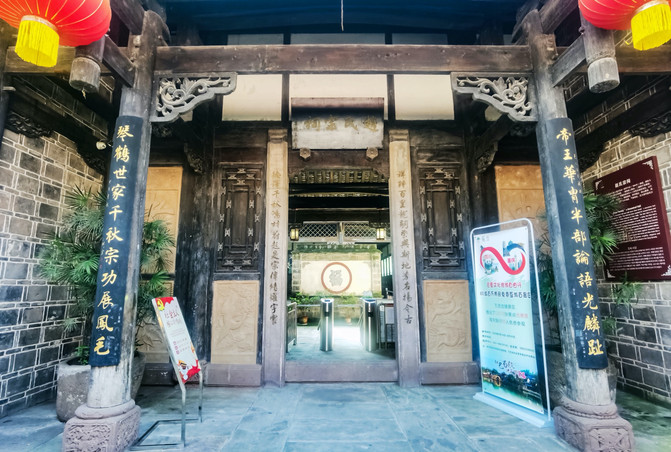
Wanling Town is a famous historical and cultural town in China. With its dynamic soil and water, it can be said that the ancient town is blessed with talented people. The hardworking and intelligent people of Wanling have created its unique historical and cultural heritage. Fourteen intangible cultural heritages, such as Silk Fist, Wanling Recreation, New Year Pig Killing, and Loong Boat Race, have been passed down in the ancient town. Famous figures such as Yu Maojian, the Minister of Justice of the Ming Dynasty, Zhao Zongkai, a revolutionary pioneer, Liu Naifu, an anti Japanese hero, and Zhao Zongyu, known as the "father of Chinese oil", are renowned throughout history. The traditional family traditions and teachings of the ancient town, represented by Yu Maojian, known as the "Clear Officials of the World", have been promoted nationwide by the Central Commission for Discipline Inspection and have become the main filming theme of the CCTV documentary "Remembering Homesickness - Wanling Town: Clear and Honest Wind".









Tour route of Wanling Ancient Town: Starting from Taiping Gate, passing through Zhao Clan Ancestral Hall - Yanyu Lane - Riyue Gate - Along the River - Shuilian Lane - Eighteen Stairs - Round Stone Brick Pillars - Lion Gate - Huguang Guild Hall - Qinfang Pavilion - Erya Academy - Hengsheng Gate.
Recommended Rongchang cuisine: Rongchang braised white goose, bedding noodles, fermented black bean fish
Thank you for browsing
I am Chongqing Mohai, a self media person who started photography. I have been studying photography for 10 years and have been awarded the title of tourism photography. I am currently mainly engaged in experiential promotion in tourism, hotels, food, photography, and other fields. Signed partnerships with multiple websites and television stations, and organized joint activities with tourism bureaus and companies in multiple provinces and cities. I have traveled to every province and city in China, passing through every scenic spot and hotel.
Previous Article:2700 kilometers from "Mountain City" to "Magic City" - Together with SAIC Volkswagen PHEV
Next Article:Chongqing Cultural Picture | Manxingji of Daxigou Trail Group
